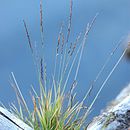Comprehensive Description
provided by North American Flora
Agrostis humilis Vasey, Bull. Torrey Club 10: 21. 1883
Perennial; culms cespitose, slender, erect, 1-noded near the base, usually not more than 15 cm. tall; leaves mostly basal, the sheaths glabrous; ligule obtuse, about 1 mm. long; blades flat or folded, glabrous beneath, minutely pubescent on the upper surface, mostly less than 10 cm. long, about 1 mm. wide or often less; panicle narrow, purple, 1-3 cm. long, rarely longer, the branches appressed or somewhat spreading; glumes 1.5-2 mm. long, glabrous except the slightly scabrous tip of keels; lemma nearly as long as the glumes, awnless; palea about two thirds as long as the lemma.
Type locality: Mt. Adams, Washington {Howell 85).
Distribution: Bogs and alpine meadows at high altitudes, Wyoming to Washington and Oregon.
- bibliographic citation
- Albert Spear Hitchcock. 1937. (POALES); POACEAE (pars). North American flora. vol 17(7). New York Botanical Garden, New York, NY
Physical Description
provided by USDA PLANTS text
Perennials, Terrestrial, not aquatic, Stems nodes swollen or brittle, Stems erect or ascending, Stems caespitose, tufted, or clustered, Stems terete, round in cross section, or polygonal, Stem internodes hollow, Stems with inflorescence less than 1 m tall, Stems, culms, or scapes exceeding basal leaves, Leaves mostly basal, below middle of stem, Leaves conspicuo usly 2-ranked, distichous, Leaves sheathing at base, Leaf sheath mostly open, or loose, Leaf sheath smooth, glabrous, Leaf sheath and blade differentiated, Leaf blades linear, Leaf blades very narrow or filiform, less than 2 mm wide, Leaf blades mostly flat, Leaf blade margins folded, involute, or conduplicate, Leaf blades mostly glabrous, Ligule present, Ligule an unfringed eciliate membrane, Inflorescence terminal, Inflorescence a contracted panicle, narrowly paniculate, branches appressed or ascending, Inflorescence solitary, with 1 spike, fascicle, glomerule, head, or cluster per stem or culm, Inflorescence branches more than 10 to numerous, Lower panicle branches whorled, Flowers bisexual, Spikelets laterally compressed, Spikelet less than 3 mm wide, Spikelets with 1 fertile floret, Spikelets solitary at rachis nodes, Spikelets all alike and fertille, Spikelets bisexual, Spikelets disarticulating above the glumes, glumes persistent, Spikelets disarticulating beneath or between the florets, Rachilla or pedicel glabrous, Glumes present, empty bracts, Glumes 2 clearly present, Glumes equal or subequal, Glumes equal to or longer than adjacent lemma, Glume equal to or longer than spikelet, Glumes 1 nerved, Lemmas thin, chartaceous, hyaline, cartilaginous, or membranous, Lemma 5-7 nerved, Lemma glabrous, Lemma apex truncate, rounded, or obtuse, Lemma awnless, Lemma margins thin, lying flat, Lemma straight, Palea present, well developed, Palea membranous, hyaline, Palea shorter than lemma, Palea 2 nerved or 2 keeled, Stamens 3, Styles 2-fid, deeply 2-branched, Stigmas 2, Fruit - caryopsis, Caryopsis ellipsoid, longitudinally grooved, hilum long-linear.
Agrostis humilis: Brief Summary
provided by wikipedia EN
Agrostis humilis is a species of grass known by the common names of mountain bent grass and alpine bentgrass, which can be found in Western United States and Canada.
- license
- cc-by-sa-3.0
- copyright
- Wikipedia authors and editors

